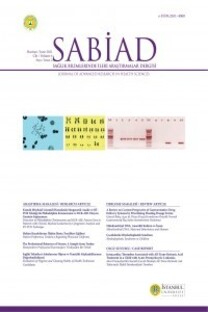ANTIMETASTATIC POTENTIAL OF CUCUMIN IN ANAPLASTIC THYROID CANCER AND COMBINED ACTIVITY WITH DOCETAXEL
Anaplastic thyroid cancer (ATC) is one of the deadliest human malignancies, with no effective treatment, survival limited to a few months. The disease is characterized by a high rate of metastasis and is resistant to almost all available cytotoxic. There is an urgent need for chemicals with an effective, low toxicity profile. Objective: In study, the antimetastatic property of tetrahydrocurcumin (THC), the active metabolite of Curcuma Longa, was compared with docetaxel and the presence of synergism in the combination of the two substances was investigated in vitro. Material and Method: IC25 and IC50 concentrations of THC and (DX) in CAL62 and 8505C cells were determined by modified MTT method we developed in our laboratory. These 2 concentrations were compared with the control in the treatment groups. Cell motility as an indicator of metastatic potential was evaluated by in-vitro wound healing method. Cellular cytotoxicity was evaluated by TAS-TOS analyses. Results: In the 8505C cell line, Total antioxidant status was observed in the DXB-CRC IC50/2 group with a significant statistical increase. THC significantly reduced the oxidative stress index in the highest combination group, especially in DXB. It was found that the combined dose prevented migration and invasion in CAL62 cells in the first hours. There was no difference in Total Oxidant level between the combination and control groups. It was observed that the most effective dose that significantly reduced the oxidative level was DX50. THC in ATK cells has antimetastatic potential close to Docetaxel; It was thought that docetaxel reduced oxidative stress.
ANTIMETASTATIC POTENTIAL OF CUCUMIN IN ANAPLASTIC THYROID CANCER AND COMBINED ACTIVITY WITH DOCETAXEL
Anaplastic thyroid cancer (ATC) is one of the deadliest human malignancies, with no effective treatment, survival limited to a few months. The disease is characterized by a high rate of metastasis and is resistant to almost all available cytotoxic. There is an urgent need for chemicals with an effective, low toxicity profile. Objective: In study, the antimetastatic property of tetrahydrocurcumin (THC), the active metabolite of Curcuma Longa, was compared with docetaxel and the presence of synergism in the combination of the two substances was investigated in vitro. Material and Method: IC25 and IC50 concentrations of THC and (DX) in CAL62 and 8505C cells were determined by modified MTT method we developed in our laboratory. These 2 concentrations were compared with the control in the treatment groups. Cell motility as an indicator of metastatic potential was evaluated by in-vitro wound healing method. Cellular cytotoxicity was evaluated by TAS-TOS analyses. Results: In the 8505C cell line, Total antioxidant status was observed in the DXB-CRC IC50/2 group with a significant statistical increase. THC significantly reduced the oxidative stress index in the highest combination group, especially in DXB. It was found that the combined dose prevented migration and invasion in CAL62 cells in the first hours. There was no difference in Total Oxidant level between the combination and control groups. It was observed that the most effective dose that significantly reduced the oxidative level was DX50. THC in ATK cells has antimetastatic potential close to Docetaxel; It was thought that docetaxel reduced oxidative stress.
___
- Arayıcı ME YF, Ellidokuz H. Importance of Cancer Registration and its Place in Cancer Control. Sted. 2021;30(5):366-75.
